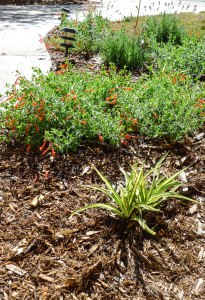
Kick-ass plants can provide color and interest even when they’re not in bloom. In this fall landscape, you’ll see (clockwise from lower left) Genista lydia, fiery Pawnee Buttes sand cherry, Sonoran sunset hyssop, sunset hyssop, blue avena grass, and orange carpet hummingbird.
Unless you’re one of those rare Colorado gardeners with a shady yard, you probably have spots that get blasted by the sun—in other words, badass areas. And you likely have heavy clay soil, too.
The southwest corner of my front yard is badass. Besides getting hammered by western and southern sun, the area sits next to a sidewalk, which radiates heat.
So when I designed this space, I selected kick-ass, drought-tolerant plants with fall color and winter interest in mind. I also wanted most, if not all, of the plants to attract pollinators. Here are the plants that made the cut.

Around July, these kick-ass plants burst with color, particularly the fuchsia-colored Sonoran sunset hyssop, salmon-and-lavender sunset hyssop, and neon orange carpet hummingbird. The Genista lydia in front erupts in electric yellow flowers in the spring. Pawnee Buttes sand cherry, behind the genista, produces white flowers in the spring. Because of their successional bloom, the plants (other than the blue avena grass) provide nectar to pollinators throughout the growing season.
Lydia broom (Genista lydia). This evergreen, groundcover shrub explodes with electric yellow flowers in the spring. Its branches are somewhat scruffy, which is probably why you can’t find it in nurseries these days. However, there’s a new smaller cultivar with more attractive branching: Lydia bangle broom (Genista lydia ‘Select’). Bangle grows 12-24 inches high and 18-24 inches wide, and produces the same showy yellow flowers that Genista lydia I haven’t seen this plant in Fort Collins nurseries yet, but The Tree Farm in Longmont sells it. So I’m guessing this cultivar will migrate north to local nurseries before long.
Pawnee Buttes sand cherry (Prunus besseyi). In April, this low-growing shrub pumps out fragrant white flowers, followed by black berries in the summer. In the fall, this plant’s foliage is pure magic, when sunlight catches its fiery red leaves. Then in winter, Pawnee Buttes’ perky little branches stand at attention. This shrubby ground cover will reach 15-18 inches high and 4-6 feet wide. Don’t let its width scare you, though. Pawnee Buttes responds very well to pruning if you want to keep its width at four feet or so.
Sonoran Sunset hyssop (Agastache cana ‘Sinning’). This herbaceous, woody-based perennial blooms prolifically with fuchsia flowers from early June through October. Then in late fall, its blooms turn tan, providing winter interest. Pollinators, especially hummingbirds, love it. Sonoran Sunset grows 15-18 inches high and 12-15 inches wide. If you have heavy clay soil, be sure to amend it with compost to improve drainage. Once this plant is established, don’t overwater it. I’ve killed a couple that way in a moister part of my yard.
Sunset hyssop (Agastache rupestris). Sunset hyssop features salmon-and-lavender blooms. It’s taller than Sonoran, reaching 2-4 feet high by 20-30 inches wide. So I plant it as a backdrop to Sonoran. Agastache has a reputation for being a short-loved perennial, but all of my sunset hyssops are going into their fourth season.
Orange carpet hummingbird (Zauschneria garrettii). As the common name suggests, this plant is beloved by hummingbirds for its tubular, neon-orange blooms from June to October. Zauschneria spreads quickly and grows 3-4 inches high by 15-20 wide. It’s one of those plants you’ll be able to share with neighbors.
Blue oat grass (Helictotrichon sempervirens). It’s not easy to find blue plants for a garden’s color scheme. That’s one reason I like blue oat (avena) grass so much. Unlike many ornamental grasses, blue oat grass, doesn’t reseed and take over your yard. This well-behaved plant delivers arching stalks of airy plumes in early summer, and grows about 2-3 feet high and wide. This is the only plant in my badass area that doesn’t provide nectar for pollinators.
Cut the hyssops and blue oat grass to the ground in March or April as new growth emerges.
All of these plants offer nearly year-round interest except for orange carpet hummingbird, which dies back in winter. They also bloom at different times so that pollinators have food sources throughout the growing season.
On April 14, I’ll be offering two short programs on kick-ass plants at the Sustainable Lifestyle Expo at the FirstBank Center in Broomfield, Colorado. Colorado State University Extension agents, specialists and volunteers will provide research-based demonstrations and talks on more than 30 topics. Expo tickets are $10 for adults. Admission is free for ages 17 and under.











